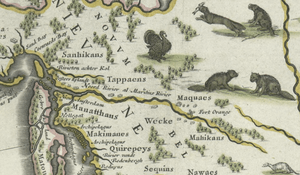Achter Kol, New Netherland facts for kids
Achter Kol was the name given to a special area in what is now northeastern New Jersey. This region included the Newark Bay and the Hackensack River. It was part of a larger Dutch colony called New Netherland in the 1600s. The Dutch West India Company first managed this area. When Europeans arrived, the land was already home to Native American groups like the Hackensack and Raritan, who were part of the larger Lenape people.
Why Was It Called Achter Kol?
When Dutch explorers and settlers named places, they often described where they were located, their shape, or their land features. Today, Newark Bay connects to Upper New York Bay through the Kill Van Kull. It also connects to Raritan Bay through the Arthur Kill. These names come from the time when the Dutch were in charge.
The area around the bay and its rivers was called Achter Kol. In Dutch, "achter" means behind, and "col" means a mountain pass. So, Achter Kol means behind the ridge. This ridge was Bergen Hill, which is part of the Hudson Palisades. The Palisades start on Bergen Neck, a piece of land between the bay and the Hudson River. A "kille" in Dutch means a stream or channel.
- The name Kill van Kull literally means channel from the ridge.
- Arthur Kill is an English version of achter kill, meaning back channel. This name describes its location behind Staten Island.
Who Lived Here First? Early Settlers
Achter Kol was close to a large land grant called Pavonia. This land was first given out in 1630, but it went back to the Dutch West India Company in 1636. The homes in Pavonia were mainly in places like Communipaw and Harsimus, along the North River (Hudson River).
David Pietersen de Vries was an early European landowner in this area. He was a Dutch sea captain, explorer, and trader. He had already started settlements in other places like Zwaanendael Colony, Staten Island, and Vriessendael. In a book he wrote in 1655, de Vries described how the Lenape people hunted deer. They would form a long line, beating bones to scare animals towards a river. This made it easier to catch them. They also used lassos, drowned deer, or set fires to catch prey.
In 1642, a man named Myndert Myndertsen received a large land grant north of Newark Bay. He wasn't there himself, so he hired Johannes Winckelman to build a farmhouse. This house was finished the same year, near what is now Bogota. It was close to a Hackensack village.
Later, there were conflicts that started a war called Kieft's War in 1643. The people living at Myndertsen's homestead were first spared. But then they were told to move to the safer Fort Amsterdam. Soldiers with cannons replaced them. The Hackensack people saw this as an act of war. Their homestead was later attacked and destroyed. The Achter Col Colony was not rebuilt. This area later became known as the English Neighborhood.
After some time, relations with the Hackensack Lenape improved. Oratam, the leader (or sachem) of the Hackensack, worked peacefully with the Dutch. Sarah Kiersted was a big help because she knew the Algonquian language. She worked as a translator and writer. In 1666, Oratam gave her a large piece of land (about 2260 acres) between the Hackensack River and Overpeck Creek. This was a thank you for her help as a translator.
In late 1654, more land grants were made "achter Kol." These led to small communities like Pamrapo and Minkakwa. Eventually, in 1665, Oratam officially gave the land to the Dutch. A picture of Chief Oratam is even on the Hackensack town seal today. By this time, the lands west of the Hudson River (which are now Hudson County, the Palisades, the Meadowlands, and the Hackensack River Valley) were called Bergen. Its main office was set up in a village at today's Bergen Square in 1660.
When the English took over the area, they kept its Dutch name. In 1675, the East Jersey government created the first four counties of New Jersey: Bergen, Essex, Middlesex, and Monmouth. Philip Cartaret, the governor of the colony, gave land to Captain John Berry. Berry settled in the southern part of the area and called it New Barbadoes Neck, after the island of Barbados where he used to live.



